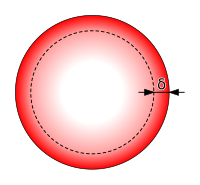
Photo from wikipedia
This article re-evaluates flat windings to improve the current density of concentrated windings. The article produces finite element and lumped parameter thermal models to compare the thermal profile of the… Click to show full abstract
This article re-evaluates flat windings to improve the current density of concentrated windings. The article produces finite element and lumped parameter thermal models to compare the thermal profile of the new flat winding construction with traditional concentrated windings of square cross-sectional area. An experimental setup is developed to validate the models which are then used to establish the thermal profile and current density of the two constructions. Traditional concentrated windings are shown to have a number of thermal resistances across their interwinding layers. A hot spot temperature is therefore produced at the winding with the longest thermal path. Flat windings as proposed here eliminates this problem, leading to lower temperatures. As a result, higher current can be injected before the maximum allowed temperature is reached. The article demonstrates that for a typical motor operating point of 300 N·m and 1500 r/min the maximum temperature is reduced by 97 K. For the same maximum temperature, the current density can be increased between 130%–150%.
Journal Title: IEEE Transactions on Industry Applications
Year Published: 2021
Link to full text (if available)
Share on Social Media: Sign Up to like & get
recommendations!